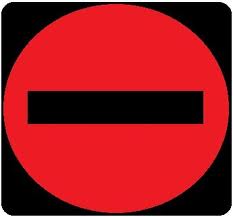Sponsored Links
The Concept of Negation in Logic
© 2012 byJensen dG. Mañebog
 THE CONCEPT OF NEGATION introduces another operator which is so functional in logical operations, especially in determining the truth of falsity of compound statements with negated components. By operator, we mean a symbol, term, or other entity that performs or describes an operation, like the compound-statements symbols.
THE CONCEPT OF NEGATION introduces another operator which is so functional in logical operations, especially in determining the truth of falsity of compound statements with negated components. By operator, we mean a symbol, term, or other entity that performs or describes an operation, like the compound-statements symbols.
Considered by some logicians as a special kind of compound statement, negation is a statement of denial or contradiction. It can also be interpreted as an assertion that a particular statement is false. The symbol used for negation is the tilde (~) or simply the negative sign (-). “It is not the case that”, “it isn’t true that”, and “it is false that” are the phrases that usually express the idea of negation. Sometimes, the single word ‘not’ embedded in a sentence is enough to indicate negation.
Examples:
It is not the case that Trillanes is Chinese. (-T)
It isn’t true that Azkals is a basketball team. (-A)
It is false that Obama is from Olongapo. (-O)
Mayweather is not gay. (-M)
Negation, as a truth-functional operator, simply reverses the truth value of any statement—simple or compound—in front of which it appears. If the original is true, the negated statement is false; and if the original is false, the negatedstatement is true. Examples:
If the statement “Peter is an apostle” (P) is true, then its negative counterpart “Peter is not an apostle” (-P) is false.
And, if the statement “Peter is a Samaritan” (P) is false, then its negative counterpart “Peter is not a Samaritan” (-P) is true.
The concept of negation thus states that “-Pis false when P is true” and that “-Pis true when P is false.” The truth table of Negation thus appears as follows:
P -P
T F
F T
Remember that the negation sign is always placed in front of the statement it negates, not between two propositions as in the case of all other operators. It is because negation is the only operator that is not a connective, that is, it does not join statements into compounds.
Thus, P - Q is not a proper expression. But the negation sign is the only operator that can immediately follow another operator. Thus, it would be correct to write P&-Q.
The negation sign can also be used to negate a compound proposition. For instance, in the case of -(P&Q) the negative sign negates the entire expression inside the parentheses. Since thenegation sign is outside the parentheses, it affects the entire compound, not just the first component, P.
Application
As an application, let us talk about double negation and double negative which are necessarily linked to the concept of negation.
Double negationstands for “negation of negation”. This principle in Logic states that a statement and the negation of its negation mean one and the same thing. To avoid confusion, this principle reminds us that “two negatives make an affirmative.” So when your mother emphatically tells you, “It is not true that you are not telling a lie”, she is insistently proposing, “You are telling a lie.”
Aside from being used for emphasis, double negation can be an effective counter statement. In defying the claim that his client is not innocent, a lawyer may say, “It is not true that my client is not innocent.”
Double negation is related to double negative in the sense that both use two negatives. In Grammar however, double negative specifically refers to a phrase containing two negatives.
Some carelessly constructed double negatives are no longer considered illiterate in current standard English. For instance, the expression, “I don't know nothing” in which two negatives close together are intended to emphasize each other, is no longer acceptable. But double negatives like, “That's not a good idea, I don't think”, in which the reinforcing negatives appear in different clauses, are considered literate. The double negative “It is not impossible” which is equivalent to “It is definitely possible” can be correctly used for emphasis or as a counter statement. We can therefore conclude, “It is not impossible to learn practical things from Logic.”
How to cite this article:
Jensen dG. Mañebog. “The Concept of Negation in Logic” @ www.OurHappySchool.com





Comments
metabolic rate ... (not verified)
Sat, 07/27/2013 - 15:04
Permalink
Reply to comment | Your Online ACADEMIC & Entertainment Magazine
Add new comment